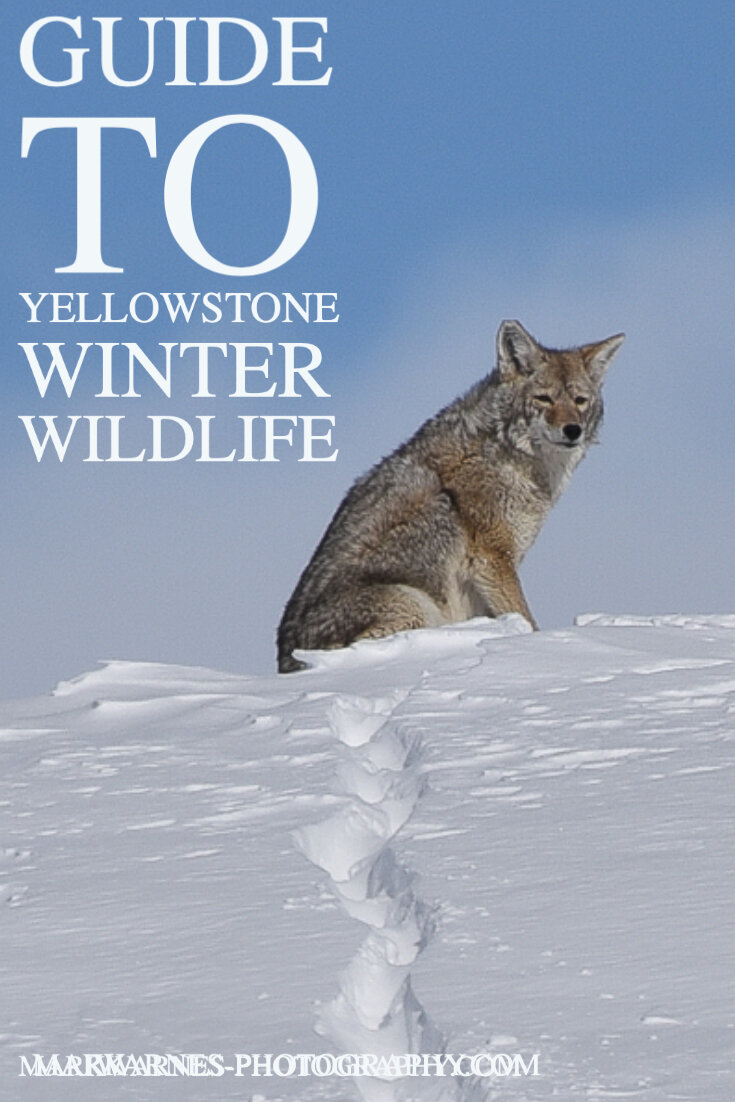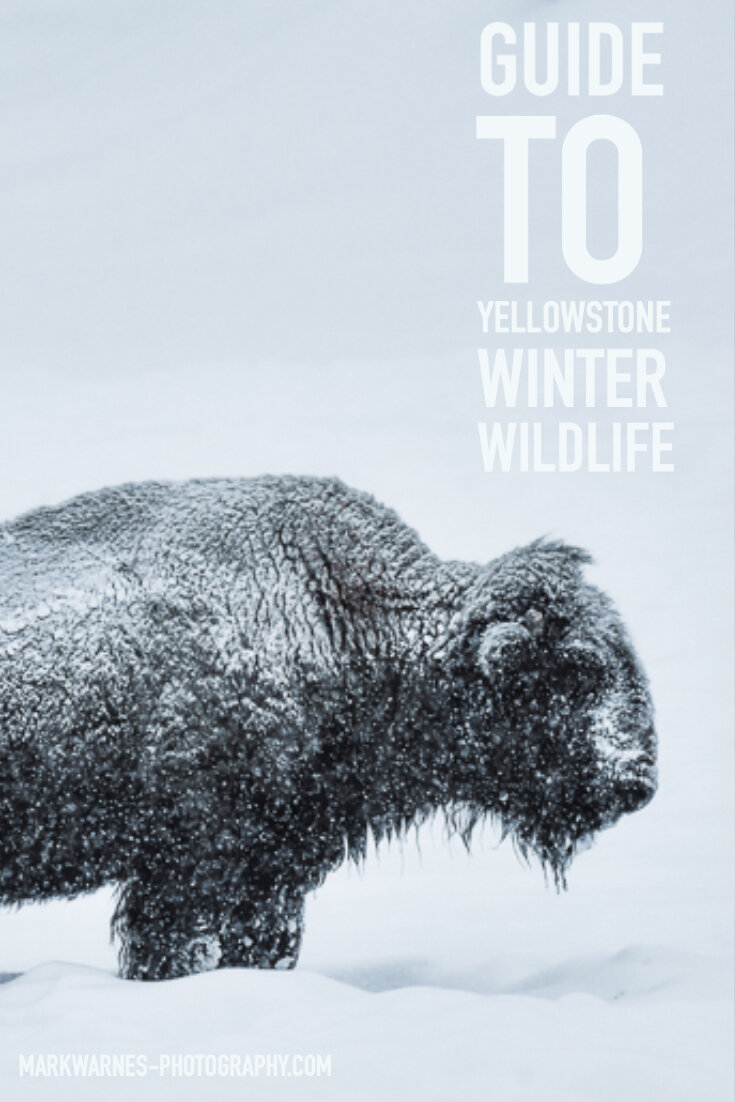A Photographers Guide to Yellowstone’s Winter Wildlife
The only thing better than photographing Yellowstone, is photographing Yellowstone in the winter. If you can brave the cold, you're in for a very memorable photography trip where you're sure to capture some very special photos.
Yellowstone in winter is a true wonderland—a place of natural beauty and inspiration, with steaming thermal features, incredible snowy landscapes and incredible wildlife viewing.
What to Expect
There is only one entrance to Yellowstone open to the public during the winter months–the north entrance near the city of Gardiner, Montana. This entrance provides the only vehicular access to Mammoth Hot Springs, Tower Falls and the wildlife Mecca of the Lamar Valley to Cooke City.
The other option is on a paid for snowcoach or snowmobile. Access here is via West Yellowstone and provides access to the main thermal features, Yellowstone Grand Canyon, Hayden Valley, the lake and Madison River. I would suggest hiring a snow coach for a number of days.
There is no access between the south and north of the park.
Yellowstone is COLD in the winter and the weather very unpredictable. Pack with adverse weather in mind. Think layers, thermals, down jacket, waterproof, gloves, hat and boots.
In winter, the park experiences a deep freeze that transforms the landscape into a seemingly lifeless wasteland of snow and ice. The temperatures range from 0 to 30F throughout the day and sub-zero temperatures are common at night on the high plateaus.
Recommended Gear
You can't get too long of a lens for shooting in Yellowstone. I’d recommend a minimum of 300mm, preferably the long zoom such as a 150-600 or 200-500mm. The long zooms are great for hand held shots and moving around in the snow.
I’d recommend packing a 24-70, 70-200 and 200-500/600 with the addition of a wide angle lens and a 50mm is room permits.
A tripod is a good option but go for a carbon fibre one rather than a metal aluminium one that will freeze.
The cold will drain batteries really quickly so make sure you pack 4 or 5. I use a ColdcaseGear bag which will insulate against the cold. Its also great for your mobile phone and to stop snacks freezing. https://coldcasegear.com
Other items I would pack would be a rain/snow cover, hand warmers, good photography gloves such as Vallerret, resealable plastic bags or dry bags, bean bag, waterproof gear bag and binoculars.
Again, remember its very cold, so dress appropriately. I can’t emphasis this enough.
Coyotes
The coyotes in Yellowstone during the winter are some of the most abundant and fascinating animals to watch. With their gorgeous full winter coats, they look stunning against the bright white snowy landscape.
Most reported sightings of wolves are actually coyotes. So how do you tell the difference? Size is the biggest indication: A wolf can be two to three times bigger than a coyote (male wolves are about four to six feet long from nose to tail tip), and coyotes’ coats are always uniform — grizzled gray on top, buffy brown on the sides, and pale on the tummy (wolves’ coats can vary in color from black to white). Coyotes also have pointier, foxier faces, and when they run, their tails — longer and fluffier than a wolf’s — curve slightly at the end; wolves’ tails always carry straight.
Most active at dawn and dusk, coyotes prey on small rodents, and they’re generally seen in ones or twos rather than larger packs.
Foxes
Foxes are abundant in Yellowstone, but far more skittish than the coyotes. Again usually lone and active at dusk and dawn. Watch out for them leaping up and down into the snow after mice and voles.
Bison & Elk
Bison and Elk are undoubtedly the most commonly seen animals in Yellowstone.
In the winter, the bison are arguably the most beautiful animals in Yellowstone with the bright white snow contrasting against the deep, dark hair on their heads. You will see many Bison with snow covered frozen heads and coats living in the most bleak of locations. Find them around geyser basins and the northern range
Just remember to have a respect for both the elk and bison in Yellowstone. Bison may look like glorified cows, but they are the most dangerous animals in the park if you get too close.
Most of the elk will have migrated from the park to warmer areas but you will see several small groups, notably along the Madison river or in and around Gardiner.
Bighorn Sheep
Bighorn sheep are abundant in the park, but they always travel in small herds so you won't run into them constantly.
Bighorn sheep are not skittish at all. You can park your car quite close to them and shoot comfortably without them worrying about you. It's easy to get a nice tight face shot, but I recommend waiting until it does something more interesting than just staring at the camera.
Wolves
Photographing the wolves in Yellowstone is pretty tough. You maybe lucky enough to see wolves, but they are usually much too far away to get a shot off. You'd be incredibly lucky to see a wolf close enough to fill the frame with even the longest of telephoto lenses.
The easiest way to see the wolves is to drive along the road until you see cars pulled off the side that have long radio antennas on their vehicles. These are the biologists who follow the wolves' every move and use the radio antennas to locate their radio collars. These wolf spotters are very knowledgeable and are usually happy to talk and let you have a look through their spotting scopes.
Best locations are the Lamar valley and around the geyser basin. Watch out for carcasses that will remain for many days and will attract the wolves.
For me , the nearest I have got to them is turning up late to a carcass by Old Faithful and hearing them howling in the tree line to each other.
Moose
Year round residents found in marshy areas of the park, including lake shores and along rivers; common in the park’s southwest corner, on the banks of Yellowstone Lake, in the Soda Butte Creek, Pelican Creek, Lewis River, and Gallatin River drainages, and in the Willow Park area between Mammoth and Norris. Try also Grand Teton’s
Bald Eagles
Endemic to North America and the national symbol of the United States, the bald eagle is a huge, dark bird with a completely white head, neck, and tail. Bald eagles are often seen near rivers and lakes where they feed on fish and waterfowl, but you can also spot them hunting rabbits and other small mammals in open country. In winter, they may be spotted scavenging on the carcasses of elk and bison. Watch out for them perched atop lodge pines along the river corridors.
Mule Deer
Common throughout the park and most active and dawn and dusk. Identified by their mule like ears.
Otters
If you’re lucky in Yellowstone National Park, you’ll get a chance to see one of the park’s most playful inhabitants:,the Yellowstone river otter.
The best time to see them is in the winter. Their dark coat is easy to spot against the snow and ice on the riverbank and they don't hibernate like some other Yellowstone mammals.
Dawn and dusk are the best times to spot a Yellowstone river otter. Make sure to look in areas nearby a body of water. Their dark bodies are easier to spot against a white winter backdrop.
Pine Martens
Pine martens live throughout the park but are best seen in the northern range-these images were taken of the TV famous Pine Martens in Cooke City with thanks to Dan and Cindy Hartman.
Pine martens are fantastic climbers that prefer to live in woodlands where they live in holes in trees, old squirrel dreys or old birds’ nests. They feed on small rodents, birds, eggs insects and fruit,
Owls
Yellowstone National Park’s owl population is difficult to spot due to their nocturnal habits. However, if you’re lucky, you might catch a glimpse of one of these incredible birds.
The Great Horned Owl (below) is one of the most widespread types of owls in North America, and it’s the most common owl in Yellowstone National Park. Named for the tufts of feathers on the upper part of their head that resemble horns, the great horned owl has a light gray underside stripped with dark bars (basically stripes), a white band of feathers on its upper breast and yellow-orange eyes. They often hunt from high perches, spotting their prey and then swooping down to snatch it with large, sharp talons.
The Great Grey owl prefers to live in secluded coniferous forests, taking over abandoned hawk or eagle nests or tree stumps and claiming them for their own. They typically eat small rodents like mice and squirrels. Although the great grey owl has a massive 60-inch wingspan, the bird looks brawnier than it is. A typical adult weighs only 2-3 pounds.
Other Species
Bobcat are sometimes seen in the park, but they are much much harder too spot if you don't know where one is hanging out. Often sighted along river corridors hunting wildfowl.
Weasels/Ermine are pretty common in the park but their white fur against the white snow makes them very hard to spot.
Wolverines are in the park, but you'd be extremely lucky to see one.
The trumpeter swans are also often seen on open waters throughoute park.
Bear and Wolf Discovery Center
If you are staying or travelling through West Yellowstone I would also highly recommend stopping at the Grizzly and Wolf Discovery Center in West Yellowstone. They have wolves and bears that you can photograph up close, and unlike zoos, the park lends itself well to photos by placing the animals in natural-looking environments.
Some people don't like shooting animals in captivity, but I don't mind one bit. It's just important to be honest and not tell lies about how a photo was taken.
Grizzly bears that live at the Centre are animals that were unable to survive in the wild for different reasons. Many were orphaned when their mothers became used to obtaining food from human areas. Others had been labeled “nuisance bears” because they were becoming dangerously comfortable around humans.These animals have a second chance at the Centre. Their stories help share an important lesson. From them we learn how humans can help make sure that bears in the wild stay wild forever. The wolves were captive-born, unplanned litters and cannot be released into the wild.






























